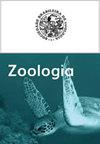Optimal foraging of Neotropical otters (Carnivora: Mustelidae) in an urban river and predominance of generalist and sedentary fish in their diet
IF 1.8
4区 生物学
Q4 ZOOLOGY
引用次数: 0
Abstract
. Lontra longicaudis Olfers, 1818 is a semi-aquatic carnivore widely distributed in the Neotropical region. Understanding their diet contributes to an indirect understanding of their ecology and the composition of the local fauna. To this end, we analyzed 109 fecal samples and identified 238 morphological structures; these samples were collected between May 2006 and September 2007 from the Santa Lúcia Biological Station (SLBS) in southeastern Brazil. The area is intersected by the Timbuí River, which arrives at the site after crossing the urban perimeter of the city of Santa Teresa in the state of Espírito Santo. We found a predominance of fish in the otters’ diets (82%), mainly cichlids (50%), which are fish with sedentary habits and low mobility levels. The crustacean Trichodactylus fluviatilis Latreille, 1828 was the third most consumed taxon; this occurred mainly during the rainy season, corresponding to the crustacean’s reproductive period, when it is more vulnerable to predation. Otters exhibited a seasonal variation in their prey selectivity. Furthermore, they displayed opportunistic foraging behavior, as the most preyed fish were those with both low mobility and a high frequency in the environment, followed by fish with high mobility and high frequency, and then those with low mobility and low frequency. We concluded that the feeding habits of the otters in the SLBS are in line with the optimal foraging theory since prey selection was optimized through the balance between net energy gained and the energy costs of foraging.新热带水獭(食肉目:水獭科)在城市河流中的最佳觅食和饮食中多面手和久坐鱼类的优势
本文章由计算机程序翻译,如有差异,请以英文原文为准。
求助全文
约1分钟内获得全文
求助全文
来源期刊

Zoologia
生物-动物学
自引率
0.00%
发文量
15
期刊介绍:
Zoologia, the scientific journal of the Sociedade Brasileira de Zoologia (SBZ), is an international peer-reviewed, open-access Zoological journal that publishes original research on systematics, evolution, taxonomy, nomenclature, biogeography, morphology, physiology, biology, ecology, symbiosis, conservation, behavior, genetics and allied fields. The journal, formerly known as Revista Brasileira de Zoologia, publishes original articles authored by both members and non-members of the Society. The manuscripts should be written exclusively in English.
 求助内容:
求助内容: 应助结果提醒方式:
应助结果提醒方式:


